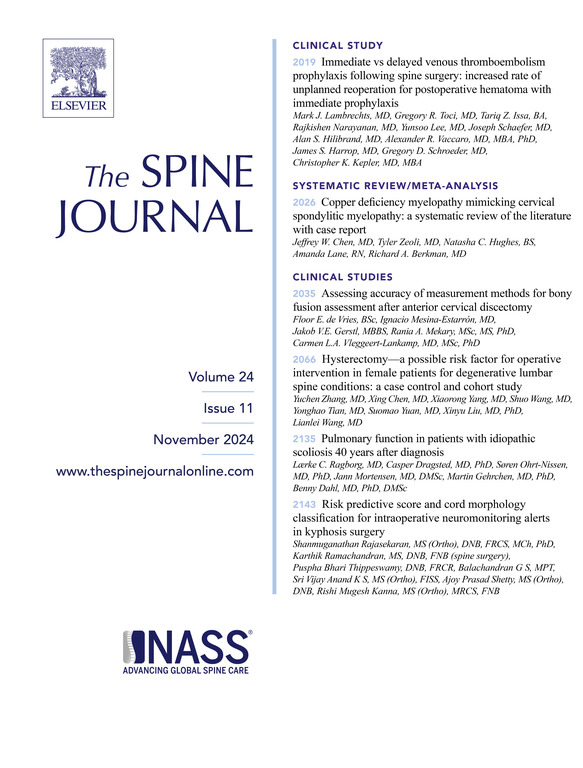关于进入门槛的态度和内窥镜减压手术相关的学习曲线:一项国际调查。
IF 4.9
1区 医学
Q1 CLINICAL NEUROLOGY
引用次数: 0
摘要
背景背景:内窥镜脊柱减压手术(ESDS)有很多好处,包括减少组织损伤、更小的切口、更短的恢复时间和更低的并发症风险。然而,在美国的脊柱外科医生中,采用它的速度很慢。不愿意采用ESDS可归因于学习曲线、设备和培训成本以及获得必要资源的机会有限等因素。目的:本研究的主要目的是评估对不采用ESDS的障碍和原因的态度。第二个目标是进一步确定考虑采用ESDS的外科医生的学习曲线、挑战和常见问题。研究设计/背景:一项来自微创脊柱外科学会(SMISS)的接受过奖学金培训的脊柱外科医生的国际调查。患者样本:来自微创脊柱外科学会的171名接受过奖学金培训的脊柱外科医生自愿并匿名地通过RedCap平台回答了我们的调查。外科医生遍布全球,代表六个地区。结果测量:获得每位回答调查的外科医生当前执业区域、专业培训、执业时间、执业类型和手术量的数据。此外,我们还获得了内窥镜技术的感知益处、进入障碍和学习曲线的数据。方法:对来自微创脊柱外科学会的接受过奖学金培训的脊柱外科医生进行调查,问题集中在可感知的益处、采用的障碍和内窥镜技术的学习曲线。结果:共有171名外科医生回应了调查,分别来自六个地区:北美(48.0%)、亚太(28.7%)和欧洲(11.7%)。受访者接受过骨科(59.1%)和神经外科(35.7%)的培训。经验各不相同,35.9%的人有超过20年的从业经验。大多数受访者在私人执业(59.6%)或学术/大学执业(39.2%),其中大多数在城市执业(67.8%)。外科医生分为使用内窥镜技术的EG组(50.3%)和未使用内窥镜技术的NEG组(49.7%)。两组之间的培训类型或工作环境没有显著差异。在NEG中,23.5%的人在培训过程中接触了内镜技术,50.6%的人在实践中接受了专门的培训,主要是通过正规的行业课程(76.7%)。采用ESDS的主要障碍是缺乏培训(55.3%)、设备不可用(50.6%)和资金问题。EG外科医生将最大限度地减少组织创伤、改善椎间孔病理检查和最大限度地缩短恢复时间作为使用ESDS的关键因素。挑战包括对不完全减压和手术时间的关注,在学习曲线中感知困难的显著差异。结论:尽管公认的ESDS的好处,障碍,如培训不足和设备成本阻碍其广泛采用。通过增加培训机会和医院系统支持来解决这些障碍,可以增加ESDS的采用,通过减少恢复时间和并发症,使外科医生和患者都受益。本文章由计算机程序翻译,如有差异,请以英文原文为准。
Attitudes regarding barriers to entry and the learning curve associated with endoscopic decompression-only surgery: an international survey
BACKGROUND CONTEXT
Endoscopic spine decompression surgery (ESDS) offers numerous benefits, including reduced tissue damage, smaller incisions, shorter recovery times, and a lower risk of complications. However, its adoption among spine surgeons in the United States has been slow. The reluctance to adopt ESDS can be attributed to factors such as the learning curve, cost of equipment and training, and limited access to necessary resources.
PURPOSE
The primary objective of this study is to assess attitudes toward barriers to and reasons for not adopting ESDS. A secondary objective is to further identify the learning curves, challenges, and common concerns of surgeons considering ESDS adoption.
STUDY DESIGN/SETTING
An international survey of fellowship-trained spine surgeons from the Society for Minimally Invasive Spine Surgery (SMISS).
PATIENT SAMPLE
A total of 171 fellowship-trained spine surgeons from the Society for Minimally Invasive Spine Surgery voluntarily and anonymously responded to our survey via the RedCap platform. Surgeons were located across the globe, representing six regions.
OUTCOME MEASURES
Data on current region of practice, specialty training, time in practice, practice type, and surgical volume was obtained for each surgeon who responded to the survey. Additionally, we obtained data on perceived benefits, barriers to entry, and the learning curve of endoscopic techniques.
METHODS
A survey was distributed to fellowship-trained spine surgeons from the Society for Minimally Invasive Spine Surgery, with questions focusing on perceived benefits, barriers to adoption, and the learning curve of endoscopic techniques.
RESULTS
A total of 171 surgeons responded to the survey, representing six regions: North America (48.0%), Asia Pacific (28.7%), and Europe (11.7%). Respondents were trained in Orthopaedic Surgery (59.1%) and Neurological Surgery (35.7%). Experience varied, with 35.9% having over 20 years in practice. Most respondents were in Private Practice (59.6%) or Academic/University settings (39.2%), with the majority practicing in urban areas (67.8%). Surgeons were categorized into the EG (50.3%) who used endoscopic techniques and the NEG (49.7%) who did not. There were no significant differences in training types or work settings between the groups. For the NEG, 23.5% were exposed to endoscopic techniques during training, and 50.6% received specific training in practice, mainly through formal industry courses (76.7%). The primary barriers to adopting ESDS were lack of training (55.3%), unavailability of equipment (50.6%), and financial concerns. EG surgeons cited minimizing tissue trauma, improved access to foraminal pathology, and minimizing recovery time as critical factors for using ESDS. Challenges included concerns for incomplete decompression and the duration of surgery, with significant variation in perceived difficulty during the learning curve.
CONCLUSION
Despite the recognized benefits of ESDS, barriers such as training deficiencies and equipment costs hinder its widespread adoption. Addressing these barriers through enhanced training opportunities and hospital system support could increase the adoption of ESDS, benefiting both surgeons and patients by reducing recovery times and complications.
求助全文
通过发布文献求助,成功后即可免费获取论文全文。
去求助
来源期刊

Spine Journal
医学-临床神经学
CiteScore
8.20
自引率
6.70%
发文量
680
审稿时长
13.1 weeks
期刊介绍:
The Spine Journal, the official journal of the North American Spine Society, is an international and multidisciplinary journal that publishes original, peer-reviewed articles on research and treatment related to the spine and spine care, including basic science and clinical investigations. It is a condition of publication that manuscripts submitted to The Spine Journal have not been published, and will not be simultaneously submitted or published elsewhere. The Spine Journal also publishes major reviews of specific topics by acknowledged authorities, technical notes, teaching editorials, and other special features, Letters to the Editor-in-Chief are encouraged.
 求助内容:
求助内容: 应助结果提醒方式:
应助结果提醒方式:


